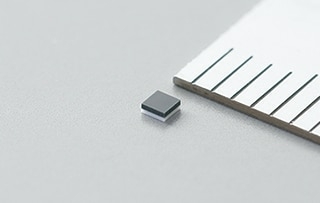source: Murata news
Today, Murata Manufacturing Co., Ltd, announces the release of our latest RAIN RFID tag designed for embeddable applications – p/n LXMSJZNCMF-198. This new product has been in production since August 2017.
Overview
RAIN*1 RFID adoption rates are rising as companies realize its value in inventory tracking and product traceability, but small consumer goods have posed a challenge due to the reduced space for labels. Murata, a primary leader in multi-layer ceramic substrate, has integrated a RAIN RFID chip and antenna to create a complete RFID tag, perfect for use on small items. The 1.25 mm square package, with a height of only 0.55 mm, is uniquely suited for use in eyewear, watches, and other wearable accessories, as well as healthcare applications like test tube sample identification.
Features
- Ultra small size, measuring 1.25 x 1.25 x 0.55mm
- Antenna is integrated into the multi-layer ceramic substrate
- Incorporates Impinj’s high-performance Monza® R6 tag chip
- Complies with UHF RFID standard ISO18000-63 and EPC Global Gen2v2
- Supports the global UHF band from 865MHz to 928MHz
Background
Impinj, a leading provider of RAIN RFID solutions, and Murata have partnered to bring RAIN RFID technology into the broader market. Taking advantage of the Impinj Monza® R6’s small die size and high sensitivity, Murata successfully developed their ultra-small integrated tag that can be either attached or embedded into a wide range of applications. It can be used not only to identify products during the manufacturing process, but also to provide traceability in the aftermarket. This supports both businesses and consumers against counterfeiting and enhances brand protection.
Two potential use cases for the LXMSJZNCMF-198 package are surgical tools and test vials. Biochemical products need to be strictly temperature controlled, which can make it difficult to scan visual labels due to condensation or contamination. The LXMSJZNCMF-198 package is small enough to be embedded directly into test vials, allowing it to be read by RAIN RFID readers for automatic vial tracking.
“Thanks to the new LXMS-198 package, manufacturers and retailers of small items can take advantage of all the benefits RAIN RFID has to offer”, said Carl Brasek, Senior Director of Product Management – Silicon Products at Impinj. “With Murata’s new package and Monza® R6’s superior performance, item size and materials are no longer barriers to using RAIN RFID solutions. We’re pleased to partner with Murata in to bring this innovative product to market.”
*Impinj and Monza are registered trademarks of Impinj, Inc.
*1 RAIN: Global alliance to popularize UHF band RFID technology into broader market. It uses GS1 UHF Gen2 standardized in ISO/IEC 18000-63.






























